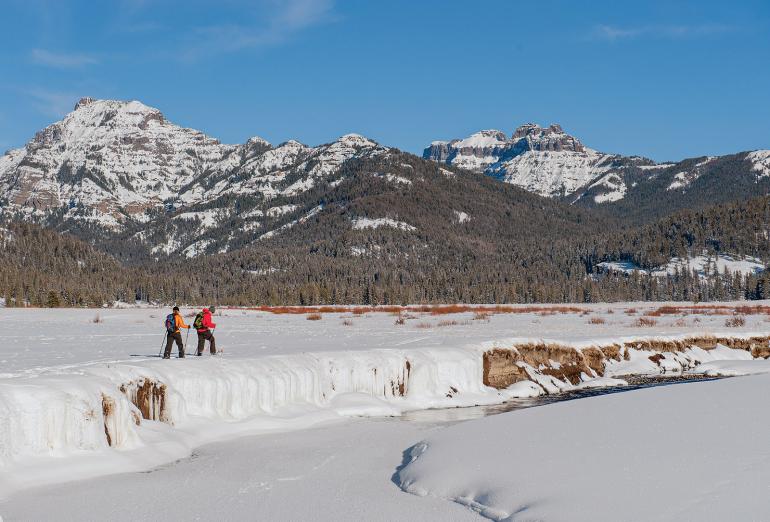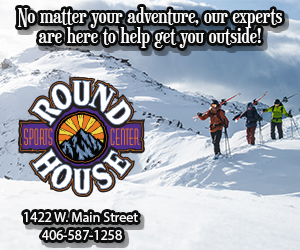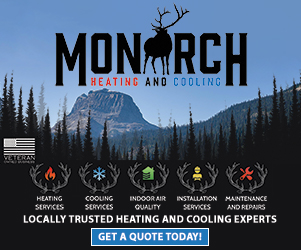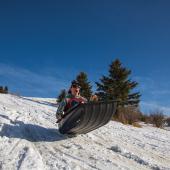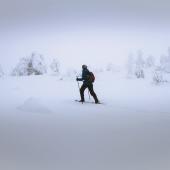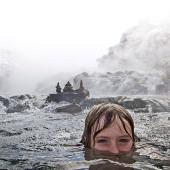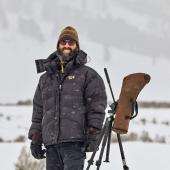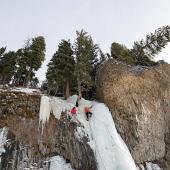Snow-comotion
A strong case for snowshoeing.
It’s nearly a half-mile from the car to our campsite. There’s enough food and gear strewn about in assorted piles and containers to outfit the Russian army—or so I think, as I’m the one who gets to transport it—and there’s nearly five feet of snow on the ground. The grand family adventure of snowshoeing and yurt camping seems now like the deranged scheme of a man in midlife crisis who should have stuck with something easier to manage—like a 500-horsepower convertible-top sport sedan.
“Snowshoeing is as easy as strapping them on and taking them off,” an industry enthusiast once told me. While I’ve found that true for my previous adventures, I’m fervently hoping it will also prove true for the kids.
Calling the boys from a huge mound of snow that they’re sliding down on their pants, I attempt to hurry them into their new snowshoes. “Are you sure I can walk on these things?” asks Dominic, the pessimist.
Many snowshoes incorporate the crampons right into the bindings. When your feet flex as they must to climb any incline, the teeth of the crampons dig into the snow, yielding incredible traction.
“Sure, you can,” I reply, my confidence buoyed by the ease at which the snowshoes are affixed to his snowboots. Snowshoeing is one of the most popular winter sports in the country, and hassle-free equipment is a major part of its appeal. Even though I’m unfamiliar with the bindings on the boys’ shoes, in minutes they’re clomping about the deserted parking lot, clamoring to challenge more demanding terrain.
They get their chance when we string out. There’s a steep incline that leads from the parking lot at ground level to the vast expanse of snow, aspen, and lodgepole pine that we’ll call home for the next few days. The boys quickly scale the “summit,” putting them on the same elevation as the rest of the snow-covered landscape. For the beast of burden dragging a sled laden with gear, the climb out of the parking lot represents a first test of my snowshoes’ traction.
I pull up behind the lads without a slip. Modern snowshoes typically sport crampons much like those used by mountaineers to traverse slippery snowfields. Many snowshoes incorporate the crampons right into the bindings. When your feet flex as they must to climb any incline, the teeth of the crampons dig into the snow, yielding incredible traction. Add a pair of ski poles with wide baskets when carrying (or pulling) a load or traversing steep terrain, and you’ll feel as much at ease as tromping around in hiking boots on a summer trail.
By the time we reach the yurt, the kids are cruising around as if they’ve grown up on snowshoes. New technology has not only lightened and streamlined snowshoes, it’s also virtually eliminated the specialized walking technique required to use the wood and rawhide snowshoes which fur trappers likely tracked in these very mountains in the previous century.
It’s estimated that snowshoeing on level ground burns about 545 calories per hour, twice the amount consumed by brisk walking.
Those traditional snowshoes were wide, flat, and lacked the foot-friendly bindings of the modern variety, forcing users to walk with a wide stance and incorporate a careful lifting rhythm into their natural stride. Modern snowshoes, by contrast, are narrow enough to accommodate a normal gait that doesn’t leave one feeling bow-legged by the end of the day. Their upturned toes also keep the tips from digging in when you step forward. Hence, there’s little learning curve to mastering technique on new snowshoes, as the antics of my two boisterous boys amply illustrate.
Snowshoes excel as a means of locomotion across landscapes covered in deep snow. I use them frequently to access rivers for winter fly fishing and waterfowl hunting when the alternative is post-holing to the Gallatin through waist-high drifts. They strap right over my wading boots for a hassle-free trip to the water.
An exceptional workout awaits snowshoers who attack the terrain. It’s estimated that snowshoeing on level ground burns about 545 calories per hour, twice the amount consumed by brisk walking. On rolling terrain, however, snowshoeing can toast more than 800 calories per hour—about 15 percent more than running at a six-mile-per-hour pace.
Whether used for a walk in the hills, a workout, or a means to some other end like fishing or photography, there’s really no simpler way to get around in deep snow than on snowshoes.


